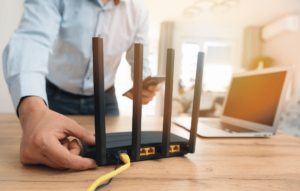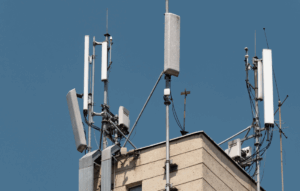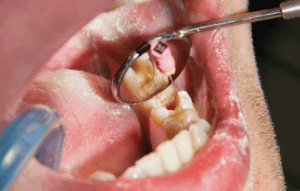Aging is a natural part of life, but certain factors can hasten this process, leading to premature wrinkles, cognitive decline, and a host of other health issues. In our modern world, we’re surrounded by an invisible force that significantly impacts our health: Electromagnetic Fields (EMFs). From the smartphones in our pockets to the Wi-Fi networks in our homes, EMFs are ubiquitous and often overlooked. Yet, emerging research suggests that these unseen forces could be accelerating the aging process in ways we are only beginning to understand.
Two major contributors to accelerated aging are oxidative stress and sleep disruption. Alarmingly, both of these can be exacerbated by continuous exposure to EMFs.
In this blog, we’ll take a look at how EMFs contribute to oxidative stress and interfere with our sleep, creating a perfect storm to accelerate aging. We’ll also explore some simple strategies to mitigate these effects, helping you take some steps to protect your health and well-being. Whether you’re already feeling the effects of aging or simply looking to maintain your youthful vitality, understanding the impact of EMFs is a crucial piece of managing your health into your later years.
So, if you’ve ever wondered why you might be feeling older than your years, read on to discover how EMFs could be playing a role and what you can do about it.
Understanding EMFs
Electromagnetic Fields (EMFs) are invisible areas of energy, often referred to as radiation, that are associated with the use of electrical power and various forms of natural and man-made lighting. EMFs are typically categorized into two types: low-frequency and high-frequency EMFs.
- Low-frequency EMFs: These are non-ionizing radiation and include sources like power lines, electrical wiring, and household appliances.
- High-frequency EMFs: These include both non-ionizing and ionizing radiation and come from sources like cell phones, Wi-Fi, x-rays, and microwave ovens.
In our daily lives, we are constantly exposed to these fields, often without realizing it. Common sources include cell phones, Wi-Fi routers, microwave ovens, and even the power lines outside our homes. While the body can handle some exposure to EMFs, the chronic exposure common in today’s digital age raises concerns about long-term health effects.
Understanding these sources and the types of EMFs they emit is crucial for recognizing the potential risks they pose, especially in terms of aging and overall health. The key to mitigating these risks lies in managing our exposure and making informed choices about our interactions with these technologies.
Oxidative Stress and Aging
Oxidative stress is a condition in which there is an imbalance between free radicals and antioxidants in the body. Free radicals are unstable molecules that can damage cells, leading to premature aging and various diseases. Antioxidants, on the other hand, are molecules that can neutralize free radicals, preventing them from causingharm.
As we age, our bodies naturally produce more free radicals while our antioxidant defenses weaken. This imbalance leads to oxidative stress, which can damage cellular components such as DNA, proteins, and lipids. The cumulative damage from oxidative stress is a significant factor in the aging process, contributing to wrinkles, reduced skin elasticity, cognitive decline, and an increased risk of chronic diseases like cancer and heart disease.
Several factors can contribute to oxidative stress, including poor diet, pollution, smoking, and, importantly, exposure to EMFs. Studies have shown that EMF exposure can increase the production of free radicals, exacerbating oxidative stress and accelerating the aging process. This is particularly concerning in our modern world, where EMF sources are omnipresent.

EMFs and Oxidative Stress
Scientific research has increasingly shown that exposure to EMFs can significantly contribute to oxidative stress, thereby accelerating the aging process. This happens through several mechanisms, primarily involving the generation of reactive oxygen species (ROS) or free radicals, which are highly reactive molecules that can cause cellular damage.
Mechanisms of EMF-Induced Oxidative Stress
- Increased Free Radical Production: EMFs can stimulate the production of free radicals within the body. These unstable molecules seek out and steal electrons from other molecules, causing a chain reaction of cellular damage.
- DNA Damage: Free radicals can harm our DNA, leading to mutations and impairing the cell’s ability to function properly. Over time, this damage accumulates, contributing to the aging process and increasing the risk of cancer.

- Lipid Peroxidation: Free radicals can also attack lipids in cell membranes, leading to lipid peroxidation. This process makes cell membranes less flexible and more permeable, compromising cell integrity and function.
- Protein Oxidation: Proteins, which perform a vast array of functions within cells, can also be damaged by free radicals. This can lead to the malfunctioning of enzymes and structural proteins, further accelerating cellular aging.
Evidence from Studies
Numerous studies have highlighted the link between EMF exposure and increased oxidative stress:
- Animal Studies: Research on rodents exposed to EMFs showed a significant increase in oxidative stress markers and cellular damage.
- Cellular Studies: In vitro studies have demonstrated that cells exposed to EMFs produce higher levels of ROS and exhibit more significant DNA damage compared to non-exposed cells.
- Human Studies: Epidemiological studies have found associations between EMF exposure and markers of oxidative stress in humans, suggesting a similar mechanism at work in our bodies.
By increasing oxidative stress, EMFs contribute to the wear and tear on our cells, accelerating the aging process and increasing the risk of age-related diseases. In the next section, we will explore how EMFs disrupt sleep, compounding their effects on aging.
Disruption of Sleep by EMFs
Sleep is an essential component of overall health and well-being, playing a critical role in the body’s ability to repair and rejuvenate itself. High-quality sleep supports cognitive function, immune health, and cellular repair processes, all of which are crucial for slowing down the aging process. However, exposure to EMFs has been shown to disrupt sleep patterns and quality, which can accelerate aging.
How EMFs Disrupt Sleep
- Melatonin Suppression: Melatonin is a hormone produced by the pineal gland in the brain, which helps regulate sleep-wake cycles. EMFs, especially those from blue light emitted by screens, can interfere with melatonin production, leading to difficulty falling asleep and reduced sleep quality.

- Altered Brainwave Activity: It has been shown that EMFs can affect brainwave patterns, which are crucial for different stages of sleep. Disruptions in these patterns can lead to lighter sleep and less time spent in restorative deep sleep stages.
- Sleep Fragmentation: EMF exposure has been linked to poor sleep quality. This prevents the body from completing full sleep cycles, which are necessary for proper rest and recovery.
Impact of Poor Sleep on Aging
- Reduced Cellular Repair: During sleep, the body undergoes critical repair processes, including DNA repair and the removal of damaged cells. Poor sleep can hinder these processes, leading to increased cellular damage and faster aging.
- Increased Inflammation: Chronic sleep disruption is associated with elevated levels of inflammation in the body. Inflammation accelerates aging and increases the risk of chronic diseases such as cardiovascular disease and diabetes.
- Cognitive Decline: Lack of quality sleep impairs cognitive function, affecting memory, concentration, and decision-making abilities. Over time, poor sleep can contribute to cognitive decline and neurodegenerative diseases.
By disrupting sleep, EMFs compound the effects of oxidative stress, creating a vicious cycle that accelerates aging.
Mitigating the Effects of EMFs
Given the significant impact of EMFs on oxidative stress and sleep disruption, taking steps to reduce exposure is crucial for maintaining health and slowing the aging process. Here are practical strategies to mitigate the effects of EMFs:

Steps to Reduce EMF Exposure
- Minimize Cell Phone Use: Limit the time spent on your phone, especially for non-essential activities. Use speakerphone or wired headsets to keep the phone away from your head.
- Optimize Home Wi-Fi: Turn off Wi-Fi routers at night or when not in use. Consider using wired internet connections to reduce exposure.
- Distance from EMF Sources: Maintain a safe distance from high EMF sources like microwave ovens, electrical panels, and major appliances. Avoid placing electronic devices near your bed.
Improving Sleep Hygiene
- Create a Sleep-Friendly Environment: Ensure your bedroom is dark, quiet, and cool. Remove electronic devices from the bedroom or place them in airplane mode to reduce EMF exposure.
- Maintain a Regular Sleep Schedule: Go to bed and wake up at the same time every day to regulate your sleep-wake cycle.
- Limit Screen Time Before Bed: Reduce exposure to screens at least an hour before bedtime to prevent melatonin suppression. Consider using blue light filters or glasses in the evening.
Lifestyle Changes to Combat Oxidative Stress
- Antioxidant-Rich Diet: Incorporate foods high in antioxidants, such as fruits, vegetables, nuts, and seeds, to neutralize free radicals and reduce oxidative stress.
- Regular Exercise: Engage in regular physical activity to boost your body’s natural antioxidant defenses and improve overall health.
- Stress Management: Practice stress-reducing techniques such as meditation, yoga, and deep breathing exercises to lower oxidative stress levels.
Aires Tech EMF Protection Devices
To further protect yourself from the harmful effects of EMFs, consider using an Aires Tech Lifetune device. These portable EMF protection devices can be carried with you wherever you go or even be directly applied to your tech, helping to mitigate exposure from various sources such as mobile devices, Wi-Fi, and other common EMF emitters.
Aires Tech’s products are backed by research and aim to provide an added layer of defense against the potential health risks posed by EMFs. By incorporating these devices into your daily routine, you can take proactive steps to safeguard your health and slow the aging process.

Closing Thoughts
Understanding the impact of EMFs on our health is more critical than ever in our technology-driven world. From accelerating oxidative stress to disrupting our sleep, EMFs play a significant role in the aging process, contributing to premature wrinkles, cognitive decline, and increased risk of chronic diseases. However, by taking proactive steps to mitigate EMF exposure, we can protect our health and slow down the aging process.
Reducing exposure to EMFs involves practical strategies such as minimizing cell phone use, optimizing home Wi-Fi settings, and maintaining a safe distance from high EMF sources. Additionally, improving sleep hygiene and adopting lifestyle changes like an antioxidant-rich diet, regular exercise, and stress management can further combat oxidative stress and enhance overall well-being.
To bolster these efforts, consider incorporating the Aires Tech Lifetune device into your daily routine. This portable EMF protection device helps mitigate exposure from various sources, offering continuous protection and reducing the potential health risks associated with prolonged EMF exposure.
By understanding the mechanisms through which EMFs affect aging and implementing these mitigation strategies, you can take control of your health, protect your body from premature aging, and maintain your youthful vitality. Prioritizing your well-being in the face of modern technological advancements is not just a choice — it’s rapidly becoming a necessity.
So, if you’re feeling older than your years, consider how EMFs might be impacting your health and take the necessary steps to safeguard yourself. Your future self will thank you.










